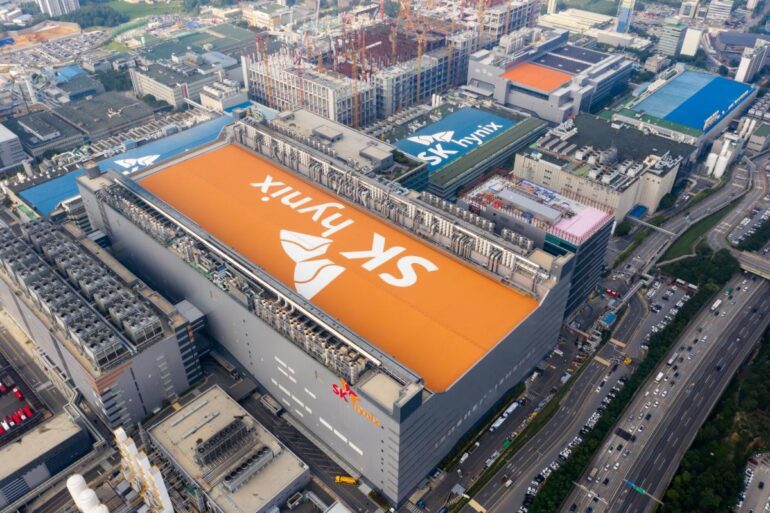- SK Hynix reports a net profit of 1.92 trillion South Korean won in Q1, a stark reversal from previous losses.
- Revenue surges by 144% to 12.43 trillion won, attributed to increased sales of AI server products.
- SK Hynix plans to boost the supply of HBM3E for AI memory and introduce 32GB DDR5 products.
- Partnership with TSMC aims to mass-produce HBM4 chips from 2026.
- Construction of a new fab in South Korea is set to bolster production of next-gen DRAM by November 2025.
Main AI News:
In the opening quarter, South Korea’s SK Hynix reported a net profit of 1.92 trillion South Korean won ($1.39 billion), marking a stark turnaround from the 2.58 trillion won loss incurred a year earlier. This marks a significant shift, signaling the company’s return to positive territory for the first time since the third quarter of 2022, as per LSEG data. SK Hynix had been grappling with net losses for five consecutive quarters due to a downturn in the memory chip market.
During the same period, revenue surged to 12.43 trillion won, marking a staggering 144% increase compared to a year ago. This robust performance catapulted the company’s revenue to its highest level since the second quarter of 2022, as revealed by LSEG data. SK Hynix attributes this impressive showing to a surge in sales of AI server products, powered by its cutting-edge AI memory technology, including high-bandwidth memory, coupled with strategic initiatives to enhance profitability.
As the world’s second-largest memory chipmaker, SK Hynix plays a pivotal role in supplying high-bandwidth memory chips crucial for AI chipsets, particularly for industry giants like Nvidia. The burgeoning demand for AI chipsets has propelled the high-end memory chip market, substantially benefiting key players like SK Hynix and Samsung Electronics.
The exponential growth in AI adoption, fueled by innovations like ChatGPT, has heightened the demand for high-performance memory chips. These chips are indispensable for enabling models to retain information from previous interactions and user preferences, thereby generating responses akin to human-like conversations.
In response to the escalating demand for AI memory, SK Hynix announces plans to ramp up the supply of HBM3E, the latest iteration of high-bandwidth memory tailored for AI applications. Additionally, the company will introduce 32GB Double Data Rate 5 products this year to fortify its dominance in the high-capacity server DRAM market.
“We are steadfast in our commitment to enhance financial performance by delivering industry-leading products while prioritizing profitability,” affirmed Chief Financial Officer Kim Woohyun.
Looking ahead, SK Hynix anticipates steady growth in the overall memory market, driven by escalating demand for AI memory, coupled with a projected recovery in the conventional DRAM market from the latter half of 2024.
While the pandemic-induced surge in demand for consumer electronics initially fueled the stockpiling of memory chips, macroeconomic uncertainties such as inflation subsequently prompted consumers to scale back purchases, dampening demand and prices for memory chips. To address the surplus inventories, companies like SK Hynix curtailed the production of memory chips.
Despite a slight decline of over 4% in SK Hynix shares on Thursday morning, the past year has witnessed a remarkable surge of over 100%.
Seizing the AI surge
In a bid to capitalize on the burgeoning demand for AI chips, SK Hynix has unveiled ambitious plans. The company announced its intention to construct a new fab in South Korea, slated for completion by November 2025, aimed at bolstering production of next-generation DRAM, including HBM, to cater to the escalating demand for AI chips. The long-term investment is projected to exceed 20 trillion won, according to SK Hynix.
Furthermore, SK Hynix has forged a strategic partnership with TSMC, the world’s leading contract chip manufacturer, to develop high-bandwidth memory 4 chips and next-generation packaging technology. Mass production of HBM4 chips is slated to commence from 2026, leveraging TSMC’s cutting-edge processes, as announced in an April 19 statement.
Conclusion:
SK Hynix’s turnaround underscores the burgeoning demand for AI memory solutions, driven by the rapid adoption of AI technologies. The company’s strategic initiatives to expand production capacity and innovate in high-performance memory chips position it well to capitalize on this growing market segment. Additionally, partnerships with key players like TSMC reflect a concerted effort to stay ahead in the competitive landscape of semiconductor manufacturing. This trajectory indicates a positive outlook for the memory chip market, particularly in the context of increasing AI integration across industries.

